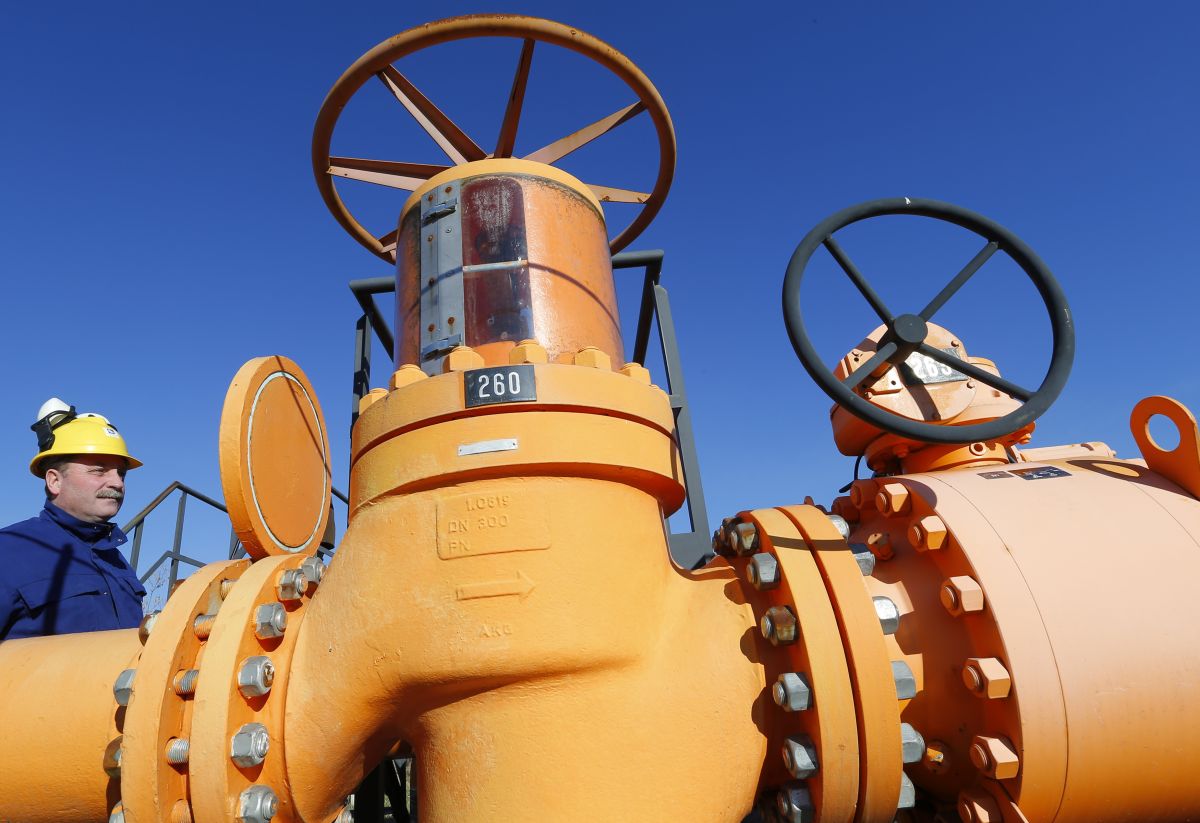Romania's Energy Policy: Implementation of the Transformation Assumptions
Romania supported the European Union's independence from Russian energy resources. The cut-off from Russian supplies would not be particularly severe for the Romanian economy, which is highly self-sufficient thanks to gas extraction and nuclear energy. Therefore, by supporting the EU's climate policy, Romania was simultaneously part of a coalition of states that persuaded the EU to include nuclear energy in its energy taxonomy. Maintaining Romania's independence will depend on resolving problems with the development of the Cernavodă Nuclear Power Plant and the extraction of gas from the Black Sea fields.
 Laszlo Balogh/Reuters/Forum
Laszlo Balogh/Reuters/Forum
Regarding Russia's invasion of Ukraine, Romania supported the EU policy to stop buying Russian raw materials. In March 2022, President Klaus Iohannis announced the country’s need to achieve energy independence rapidly. During the visit of Ursula von der Leyen, President of the European Commission (EC), to Bucharest, Iohannis also indicated renewable sources, nuclear energy, LNG and interconnectors as means serving this purpose. Romania, although declares its respect for potential sanctions on raw materials from Russia, does not advocate imposing such sanctions. After the NATO and European Council summits at the end of March, Iohannis pointed out that the immediate imposition of sanctions would be unrealistic in the context of the high dependence of some EU partners on Russian raw materials.
Romania’s Attitude Towards EU Energy Policy
Romania supports the EU's climate policy. It intends to abandon coal by 2032, which is only two years later than it is expected by the Paris Declaration of 2020 for highly developed countries. The decision is facilitated by the fact that coal accounts for just 15% of Romania's energy mix, and because of the expected closure of obsolete coal units in the coming years (five out of 13 currently in operation). Romania will also be largely supported by the EU Just Transition Fund, receiving €4.44 billion compared to Poland’s (€8 billion) and Germany’s (€5.15 billion).
The Romanian authorities are in favour of including gas and nuclear energy in the energy taxonomy. This defines sustainable energy sources to be supported by the EU until a complete shift to renewable energy. This is due to Romania’s expectations of its own gas extraction nuclear industry capabilities. Despite the resistance of Germany and Austria (both of which promote gas), in February 2022 the EC adopted a delegated act including nuclear energy in the taxonomy. It was pushed through by a coalition of the Czech Republic, France, Poland, Romania, Slovakia, Slovenia and Hungary.
Romanian Nuclear Power
The U.S. is urging Romania to purchase its new technology for small modular reactors (SMR). It suggests that, as a pioneer of their use in Europe, Romania would be able to derive profits (as yet unspecified) when SMRs are installed in other countries. In November 2021, the Romanian state-owned Nuclearenergetica (SNN) and NuScale (the owner of the technology) declared a wish to construct a six-module power plant with a capacity of 462 MW by 2028. The SMR construction offer is to compensate Romania for SNN breaking its contract (in January 2020) with the Chinese consortium for the construction of the third and fourth units at the only nuclear power plant in Cernavodă, where two units of 650 MW each generate about 20% of domestic electricity. This was a result of U.S. pressure to eliminate China from strategic sectors in Europe, but not to take over its contracts requiring credit.
The key investment for Romania, however, remains the expansion of Cernavodă. This should start in 2024, with the third block due for completion in 2030 and the fourth in 2031. The U.S. joined the project to maintain credibility as Romania's ally after the latter severed its contract with China. As a result, in December 2020, they signed a framework agreement on cooperation in the construction of new units and renovation of the first block, which will extend its life by 30 years after the original expiration date of 2026. However, the U.S. remains restrained in lending to support investments. This is evidenced by the U.S. EXIM Bank's letter of intent from October 2020 declaring cooperation with Romania only in the search for sources of financing for the project up to $8 billion. An additional challenge is the rare Canadian CANDU technology used in Cernavodă, which uses unenriched uranium. There are only 47 such reactors in the world, and none in the U.S., where companies have no experience of this technology. Therefore, in order to implement the project, the U.S. and Romania are seeking the participation of partners. In October 2020, the Romanian government signed a letter of intent with France, and in August 2021 with Canada. SNN signed a contract with a Canadian company for the implementation of technical assistance in planning renovation work and the construction of new units.
Romania wants to become once again self-sufficient in terms of nuclear fuel, as one of the few countries in the world. Therefore, the government is consolidating the nuclear industry within SNN. In March 2021, it took over the uranium concentrate refinery after the National Uranium Enterprise (CNU) went bankrupt (its unsuccessful restructuring attempts had already prompted SNN to buy cheaper concentrate in Canada from 2016). The mining of uranium ore remains a challenge, as the deposits of the only mine in the country have run out. SNN has taken over the concession for a new mine from CNU, but it will not be ready until 2023.
Romanian Gas
A possible interruption of gas supplied by Russia would not be a crucial problem for Romania. After the Netherlands, it is the largest gas producer in the EU. It consumes 11 billion m3, of which about 80% is covered by domestic production, and imports from Russia account for only about 10%. In addition, after this year's winter, the stocks are still 0.6 billion m3 (20% of capacity). The Trans-Balkan and BRUA gas pipelines also allow reverse gas transmission from Bulgaria and Hungary. However, if supplies from Russia are cut off, these countries will not have a surplus. Therefore, Romania is seeking access to gas from distant suppliers. It is pressing Greece and Bulgaria to finish this year an interconnector already delayed by 13 years. This would enable Romania to import LNG via Greek gas terminals (in April 2022, it requested access to the Revithoussa terminal). At the same time, Romania is trying to order gas from Azerbaijan and Israel.
Romania wants to be an important player on the European gas market not only as a transit country, but also as an exporter. Therefore, it aims to exploit the Black Sea shelf, the resources of which are approximately 200 billion m3. Due to this, the government accelerated work on a new offshore bill and, in April 2022, submitted a draft to parliament. It predicts that about 64% of the mining profits would go to the budget. The current bill (from 2018), which imposed a burden of about 90%, led to the suspension of works. Due to the three-year delay in its amendment, the American Black Sea Oil & Gas (the main shareholder of the Midia field, which is 90% ready to start production) announced in April 2022 its plan to sue Romania in the International Court of Arbitration. The Austrian-Romanian OMV Petrom announced in February 2022 its decision postpone to 2023 its decision to start works on the richest field, Neptun Deep, in which it holds 50% of shares. In turn, the American ExxonMobil, the owner of the remaining shares in this field, decided in November 2021 to resell them to the state-owned Romgaz for over $1 billion. Virgil Popescu, Romania’s Minister of Energy, believes the company could start mining by 2027.
Conclusions
Romania supports the independence of the EU from supplies of Russian energy resources. However, it is passive in terms of imposing an embargo on them, as it doubts that this would be successful in the face of resistance from some partners. Romania probably would have supported such a proposal more actively, if it had also been supported by Germany (Romania's most important political and economic partner). At the same time, due to its high self-sufficiency, Romania does not treat the suspension of supplies by Russia as a structural threat. This strengthens its belief in the rightness of the energy policy it has chosen. Although, in principle, Romania supports the EU programme to abandon coal in favour of renewable energy, it did not oppose gas and effectively pushed for the inclusion of nuclear power in the energy taxonomy.
The development of the nuclear and gas sector, however, faces problems in Romania. The expansion of the Cernavodă Power Plant depends on the determination of the United States, which joined the project only to maintain the credibility as Romania’s ally. However, they U.S. has been restrained in its lending, and technologically dependent on Canadian cooperation. Work on the extraction of gas from the shelf will probably start after the amendment to the offshore bill. The efficient adoption of this bill in a form acceptable to investors is, however, not certain, as the trials have already been going on for three years. The takeover of ExxonMobil's shares by Romgaz may weaken the willingness of the Romanian authorities to make concessions to private interests because (unlike them) the state-owned company may start mining, prioritising political issues over economic concerns.
From Poland's point of view, Romania's investments in the gas and nuclear sectors contribute to strengthening the energy security of the region and the entire EU. The commencement of the extraction of Black Sea gas and its subsequent export will contribute to the gradual independence of the EU from Russian raw materials. Romania will also remain an important partner for Poland on the EU forum as regards the EU's recognition of nuclear energy as a sustainable source.


